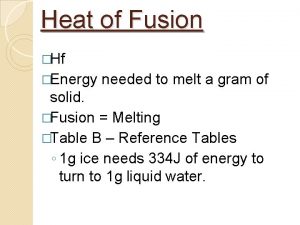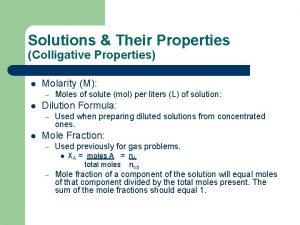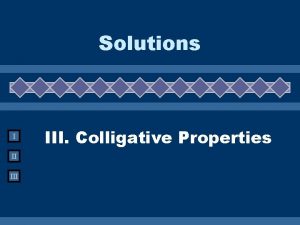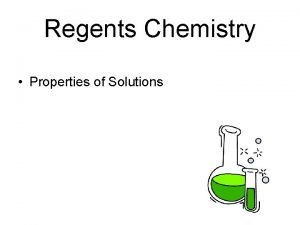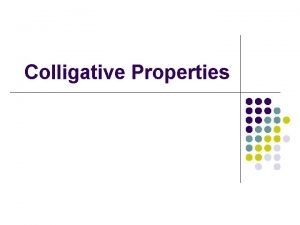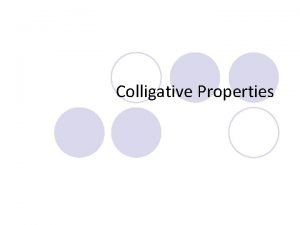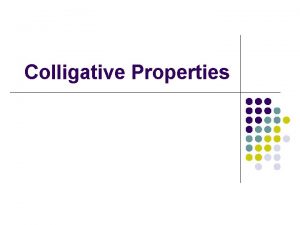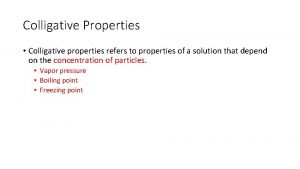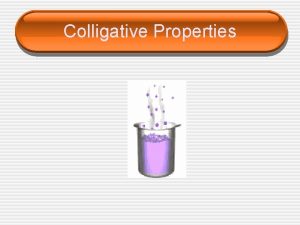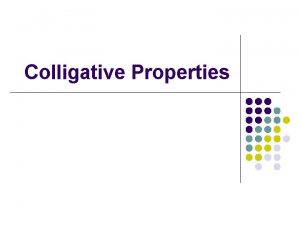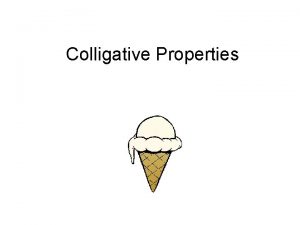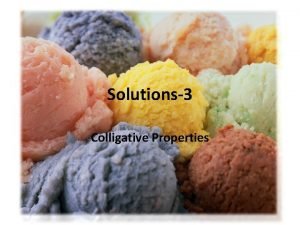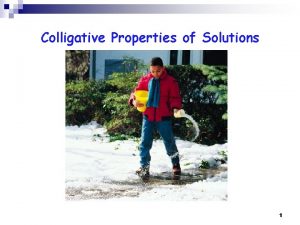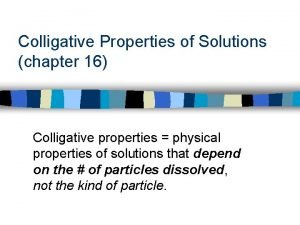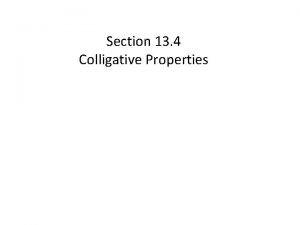Colligative Properties Colligative Properties Why does salt melt


















![A. Equal salt content in and out of cell B. [Salt]cell > [Salt]fluid C. A. Equal salt content in and out of cell B. [Salt]cell > [Salt]fluid C.](https://slidetodoc.com/presentation_image/20aadbd01825883ba1e758df3a69971f/image-19.jpg)

- Slides: 20

Colligative Properties

Colligative Properties • Why does salt melt ice? • Why does antifreeze prevent freezing in car radiators? • These are examples of the colligative properties of solutions. • Colligative properties of solutions are those properties that result from interactions between solute and solvent particles • They depend only on the ratio of solute to solvent molecules

Expressing Solute Concentration • Colligative properties are physical properties of solutions that vary depending on ratio of solute to solvent • There are 4 methods for expressing these ratios: �Molarity �Percent mass �Mole fraction �Molality

Disadvantage of Molarity • The major disadvantage of molarity as a measure of solute/solvent ratio is that molarity changes with temperature due to fluctuations of density. �Liquids expand with heating �Increasing the temperature of a solution LOWERS its molarity. • Solute concentrations expressed as % mass, mole fractions, and molality are all independent of temperature.

% Mass • % mass is used when the molar mass of the solute is unknown, or if the solute is a mixture of various substances (e. g. plant extract). • Ex. 5. 85 g of a solute is dissolved in 100. 0 g of water. What is the %mass of the solute?

Mole Fraction •

Molality • For dilute solutions containing solutes of known molar mass, it may be convenient to use molalilty (m), especially if a solution will be used over a wide range of temperatures. Molality is NOT molarity! • Ex. Calculate the molality of a solution prepared by dissolving 20. 0 g of sucrose, C 12 H 22 O 11 into 500 g of water

Examples • If 2. 8 g of lithium sulfide is dissolved in 50 g of water, determine the following: ▫ Mole fraction of the solute? ▫ Mass % of the solute? ▫ Molality of the solution? • An aqueous solution is 4. 2% ammonium chloride by mass. Calculate a mole fraction and a molality of a solution? ▫ Hint: For such a problem, it helps to make an assumption of the total mass of the solution. The most logical assumption is 100 g (4. 2 g NH 4 Cl, 95. 8 g H 2 O)

Colligative Molality • It is essential for the understanding of colligative properties to realize that it is the ratio of solute species to solvent species that determines the magnitude of a colligative effect. • For example, a 0. 10 m Na. Cl(aq) solution has twice as many solute species as a 0. 10 m glucose, C 6 H 12 O 6 (aq), solution because Na. Cl is a strong electrolyte (ionic) that produces two ions in solution whereas glucose is covalent and does not dissociate. • We can describe a secondary term called colligative molality (mc):

Colligative Molality • where i = van’t Hoff factor, m is the molality of the salt ▫ This represents the number of fragments that a molecule breaks into when dissolved in a solvent �Ex. 1. 0 m Copper (II) chloride (aq) �This ionic salt will dissociate into 3 separate ions, so i=3.

Colligative Properties: Vapor Pressure • Suppose we seal a beaker of liquid and remove all air from the headspace so that there is zero pressure. • The liquid molecules are in constant motion, and some at the surface of the liquid will break free and create vapor above the liquid, which exerts pressure. • The vapor pressure increases rapidly at first, then slows down until a constant pressure is attained, known as the equilibrium vapor pressure.

Colligative Effects on Vapor Pressure • The vapor pressure of the solvent over a solution is always less than the vapor pressure above pure solvent. • The presents of solute molecules decreases the number of solvent molecules at the surface, which means a lower surface area of the solvent. • Vapor pressure varies proportionally with the mole fraction of the solvent

Colligative Properties: Boiling Point •


Colligative Properties: Freezing Point •

Example • 50 g of magnesium fluoride(s) is added to 100 g of water. Given that the normal boiling point and freezing point temperatures of pure water are 100 o. C and 0 o. C, respectively, calculate the boiling and freezing point of this solution.

Colligative Properties: Osmosis

Colligative Properties: Osmosis • Osmotic pressure is the pressure required to stop the flow of solvent across a permeable membrane. The higher vapor pressure on the water side pushes it through the membrane into the glucose (aq) side.
![A Equal salt content in and out of cell B Saltcell Saltfluid C A. Equal salt content in and out of cell B. [Salt]cell > [Salt]fluid C.](https://slidetodoc.com/presentation_image/20aadbd01825883ba1e758df3a69971f/image-19.jpg)
A. Equal salt content in and out of cell B. [Salt]cell > [Salt]fluid C. [Salt]cell < [Salt]fluid Water flows toward the domain of higher solute concentration.

Reverse Osmosis for Purifying Water
 Chocolate melting experiment
Chocolate melting experiment Colligative properties
Colligative properties Hey hey bye bye
Hey hey bye bye Measuring heat energy
Measuring heat energy What does the acronym salt stand for in optics
What does the acronym salt stand for in optics 4 colligative properties
4 colligative properties Is molarity a colligative property
Is molarity a colligative property Colligative properties definition
Colligative properties definition Van't hoff factor of nacl
Van't hoff factor of nacl Solutions chemistry regents questions
Solutions chemistry regents questions Colligative properties of milk
Colligative properties of milk Colligative properties examples
Colligative properties examples Colligative properties worksheet
Colligative properties worksheet Properties of l
Properties of l Freezing point depression examples in real life
Freezing point depression examples in real life Colligative properties depend on the _____.
Colligative properties depend on the _____. Colligative properties depend on
Colligative properties depend on Calculations involving colligative properties
Calculations involving colligative properties Applications of colligative properties in foods
Applications of colligative properties in foods Fluid properties calculator
Fluid properties calculator Freezing point chapter 13
Freezing point chapter 13



